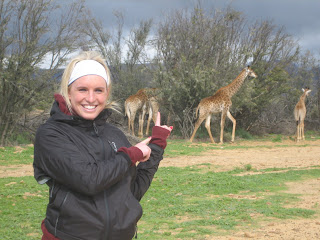


It seems as though the past week has led up to the events of today. We've devoted a great deal of time to understanding South Africa post-Apartheid in order to prepare us for seeing the true effects of it in the townships. We arrived at the JL Zwane Community Center at 9 am this mroning and were greeted by Edwin, an employee of the center for a discussion about his experiences with Apartheid and Guguletu. Edwin is a middle-aged man born of a black father and a white mother so you can imagine that he has faced a great deal of discrimination in his life. Even his own grandmother rejected him. We wrapped up the morning with two other speakers telling of their personal experiences with Apartheid.
Following our lecture a local band peformed for us. They are leaving for a US tour later this week. They perform in clinics throughout Cape Town singing, dancing, and acting, educating about HIV/AIDS. The group was composed of 6 singers (two boys and four girls), two guitar players and a drummer. I was very impressed by their talent. They performed a wide variety of songs and incorporated dance as well. It was nice to add a lighter note to the day after having three heavy speakers in the morning.
Following the performance, we were served lunch by the local women of the center. By far, it was the best meal I have had in Cape Town. We were given chicken on the bone, potatoes, vegetables, chicken curry, rice, and beverages. At this point, a lot of us are really sick of eating out -- a home cooked meal was just enough to get us through the day.
After dinner, a man gave us a tour of Guguletu from the community center. This was the first time I really feel like I've seen Africa. So much of Cape Town is similar to any other large city I've been to and seeing Guguletu really put the whole notion of Apartheid's aftermath into perspective. There are basically two types of homes in the community of 400,000 -- houses and shanties. The houses are small (probably no more than 400 square feet) and have fences built around them. The homes are not in good condition, usually run down with paint chipping off. They don't have yards, just dirt and garbage. Living in a house would be fortunate for a person, conditions in the shanties are much worse. While they are equipped with electricity, they are constructed out of anything that was available at the time -- mostly scrap metal, wood, and plastic/tarp. One particular home we visited was inhabited by a 17-year-old girl whose mother had died two years previously of complications related to AIDS and she was taking care of her 9-year-old brother. The two-room home was equipped with a makeshift kitchen and a bedroom for the remainder of her belongings. There was a single bed in the home with no bathroom. The house couldn't have been more than 150 square feet. I left the tour speechless; it is in moments like that where I don't know what to say. how could someone live in those kinds of conditions?
After our tour, we were greeted by a schoolteacher for the community center's after school program. Helping tutor the students in this program will be one of our service project for our class. I worked with two 5th graders who were working on converting time in minutes into hours and minutes. I was told by their instructor that both students are behind in their studies and it was obvious by their problems they were having with their homework. 106 -- 60 was challenging for the students.
One of the main themes of this course is about AIDS and the effects that apartheid has had on the spread of the pandemic. At this point, the whole notion of AIDS hasn't been mentioned and it's been frustrating for me. I don't think it's an issue that our speakers have necessarily ignored; it just hasn't surfaced in our conversation. My hope is that the rest of the week will be devoted to learning more about the effects of AIDS. From the surface and going through the townships, there is little to no direct reference to AIDS. Even when I spoke to the 17-year-old girl in the two-bedroom shack, she simply said that her mother died, but made no mention of HIV/AIDS.
Although a huge proportion of Guguletu's population is infected with HIV, the topic itself is mainly taboo. As a person who is incredibly curious about the disease, it's frustrating to feel like the world's greatest present pandemic is very much hush hush. The way america paints the AIDS pandemic in Africa is drastically different from what I've witnessed in the townships. When I think about the Red campaign or Bono's work, the notion of a global pandemic is greatly sensationalized. At this point, I'm a bit puzzled as to why it doesn't appear to be influential in peoples' lives. I'm hoping tomorrow will show me.
Aside from my frustrations with the whole HIV/AIDS theme of our program, this trip so far has been incredibly exhausting. There has yet to be a night where I've had a difficult time getting to sleep. We put in full days, and we usually are blogging and doing other activities at night. I'm longing for the days when I could sleep in until noon...
*posted are pictures of shanties in Guguletu, me and the giraffes at the Safari, and me at the Southern most tip of Africa*

1 comment:
Laurie,
Your blog is great. I really enjoy hearing your perspective and thought your section on the history of apartheid was amazingly informative. Hang in there with your frustrations. There are certainly more to come! :) Unfortunately or fortunately, part of the growth you'll experience will come from this frustration. I can't wait to read more.
Mandi
Post a Comment